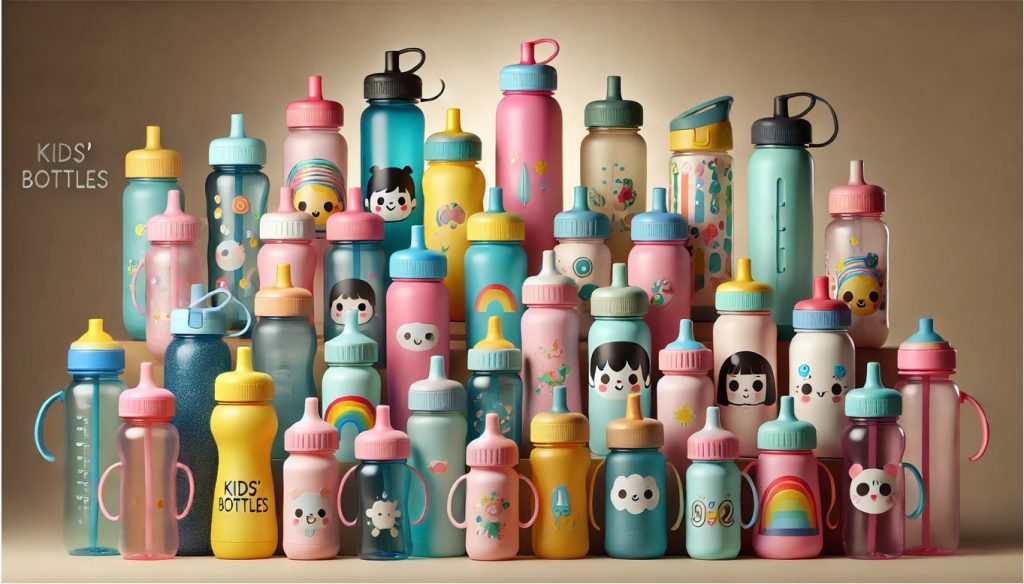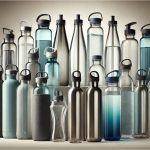Keeping children hydrated is one of the most important aspects of ensuring their overall health and well-being. But when it comes to children, hydration can be a bit tricky, especially if they are prone to making a mess or forgetfulness when it comes to closing their water bottles. One of the best solutions to this challenge is the use of leak-resistant kids’ bottles. These bottles are designed to prevent spills, keep beverages secure, and help busy parents avoid frustrating leaks in bags, strollers, or on-the-go.
What Are Leak-Resistant Kids Bottles?
Leak-resistant kids’ bottles are bottles specially designed to prevent spills or leaks, ensuring that your child’s drinks stay contained, no matter how the bottle is positioned. Whether the bottle is upside down, dropped, or packed in a bag, leak-resistant features ensure that liquid does not escape and create a mess. These bottles typically feature seals, lids, or valves designed to prevent accidental openings or spills, making them perfect for active kids who are always on the move.
How Do Leak-Resistant Kids Bottles Work?
The key to a leak-resistant kids’ bottle lies in its design. These bottles often come with special caps, valves, or locking systems that make them airtight or spill-proof. These features ensure that liquid does not flow out unless the child actively drinks from it.
- Spill-Proof Caps: These caps are designed to create an airtight seal when closed. They may feature silicone or rubber gaskets that fit tightly around the opening to prevent any liquid from spilling out, even when the bottle is tipped over.
- Bite Valves: Many bottles feature bite valves, which only release liquid when pressure is applied. This means that no liquid will flow unless the child bites down on the valve to open it.
- One-Way Valves or Flip-Top Lids: These valves or lids ensure that liquid can only escape when the child drinks. Once the child stops drinking, the valve automatically seals, preventing leakage.
All of these mechanisms work together to create a convenient, user-friendly experience for both kids and parents, ensuring that the bottle won’t cause a mess, even if it’s forgotten in a backpack or knocked over.
Types of Leak-Resistant Kids Bottles
Leak-resistant kids’ bottles come in a variety of types, each designed with different features to cater to your child’s needs. Understanding the differences will help you choose the right one based on your child’s age, activities, and preferences.
Straw Bottles
Straw bottles are one of the most popular types of leak-resistant bottles for young children. They are often designed for toddlers and younger kids who may not yet be skilled at drinking from regular bottles. These bottles typically feature an internal straw that allows kids to drink without tipping the bottle.
Features of Straw Bottles
- Built-in Straw: A built-in straw allows the child to drink without tilting the bottle, which makes it easier for toddlers and younger kids to use.
- Spill-Proof Valve: The straw often includes a spill-proof valve, which only allows liquid to flow when the child sucks on the straw. This prevents accidental spills.
- Easy to Grip: Straw bottles are often made with ergonomic shapes and handles, making them easier for younger children to hold and use independently.
- Leak-Proof Seal: These bottles typically feature a lid that tightly seals to prevent leaks even when the bottle is turned upside down.
Common Uses of Straw Bottles
- Toddlers and Preschoolers: These bottles are ideal for toddlers or children still mastering their drinking skills.
- Daycare or School: Perfect for daycare or school, where children need a bottle that’s easy to drink from and won’t cause a mess.
- Travel: Straw bottles are convenient for traveling, whether in a car seat or stroller, because they are easy to use and won’t leak in a bag.
Squeeze Bottles
Squeeze bottles are another great option for leak-resistant kids’ bottles. These bottles are designed for easy, quick drinking and are commonly used in sports and active outdoor environments. They often feature a soft, squeezable body that allows kids to quickly hydrate without unscrewing a lid or removing a cap.
Features of Squeeze Bottles
- Squeeze-to-Drink Mechanism: These bottles allow kids to squeeze the bottle to release liquid, making it easy to drink without tilting.
- One-Handed Operation: The squeeze mechanism makes it easy for kids to hydrate with one hand, which is especially useful during physical activities like running, biking, or playing sports.
- Locking Cap: Many squeeze bottles include a locking cap to keep the bottle securely sealed when not in use, preventing leaks.
- Bite Valve or Spout: The bottles often feature a bite valve or spout to prevent liquid from spilling when not in use.
Common Uses of Squeeze Bottles
- Sports: Ideal for active kids involved in sports or other physical activities, where quick hydration is needed without any spills.
- Outdoor Adventures: Great for outdoor activities like hiking, biking, or long walks where hands-free drinking is preferred.
- Travelling: Useful for travel situations where easy access to water is required, and there is limited time or ability to unscrew caps or lids.
Flip-Top Bottles
Flip-top bottles are commonly used for older kids, providing a simple and convenient drinking experience. These bottles feature a cap that flips open to reveal a spout or nozzle for drinking.
Features of Flip-Top Bottles
- Flip-Top Lid: The flip-top lid is hinged and can be easily opened with one hand, making it ideal for busy kids who are always on the move.
- Leak-Proof Seal: Many flip-top bottles have a silicone seal around the lid, preventing leaks when the bottle is closed.
- Comfortable Spout or Nozzle: The spout or nozzle often has a soft, child-friendly design, making it easy for kids to sip without spilling.
- Ergonomic Design: These bottles typically have a simple, ergonomic design that makes them easy to carry and drink from.
Common Uses of Flip-Top Bottles
- School Use: Flip-top bottles are ideal for school-aged children who need a bottle that’s quick to open and close during the school day.
- Sports: Suitable for active kids who need to hydrate quickly between sports activities.
- Commuting and Travel: Flip-top bottles are convenient for children who need a leak-resistant bottle that can be easily packed in a bag.
Wide-Mouth Bottles
Wide-mouth bottles are designed with a larger opening, which makes it easier to fill the bottle with ice, fruit slices, or other beverages, like smoothies. These bottles can also be easier to clean due to the larger opening, preventing residue or mold build-up that can be a problem with smaller-mouthed bottles.
Features of Wide-Mouth Bottles
- Large Opening: The wide opening allows for easy filling with ice, drinks, or cleaning. This makes these bottles versatile for different beverage types.
- Leak-Proof Cap: Like other leak-resistant bottles, wide-mouth bottles come with a leak-proof cap that ensures no liquid escapes.
- Versatility: Wide-mouth bottles can accommodate a variety of liquids, including water, juice, smoothies, or even milk.
- Easy Cleaning: The large opening makes cleaning easier, which is especially helpful when dealing with sticky or residue-heavy drinks.
Common Uses of Wide-Mouth Bottles
- Toddlers and Young Kids: These bottles are suitable for younger children who might prefer variety in their drinks and require easy-to-use bottles for both home and school use.
- Outdoor Activities: Perfect for outdoor use where a larger quantity of liquid is required, and for parents who prefer a bottle that can hold ice or extra ingredients.
- Sports and Active Kids: Ideal for active kids who participate in physical activities and need hydration in larger quantities.
Materials Used in Leak-Resistant Kids Bottles
When selecting a leak-resistant bottle, the material it is made from plays a critical role in its safety, durability, and functionality. The most common materials used in kids’ bottles are plastic, stainless steel, and silicone.
Plastic Bottles
Plastic bottles are the most common material for kids’ bottles, largely due to their affordability, lightweight nature, and variety of designs. However, it’s crucial to ensure that the plastic used is free from harmful chemicals like BPA, which is found in some older plastic bottles.
Benefits of Plastic Bottles
- Lightweight: Plastic bottles are easy for kids to carry, making them ideal for younger children.
- Affordable: Plastic is a budget-friendly option for parents who need multiple bottles or are looking for an economical choice.
- Variety: Plastic bottles come in a wide range of shapes, sizes, and designs, making it easy to find one that fits your child’s preferences.
Considerations
- Durability: Plastic bottles may be less durable than stainless steel and can crack or wear down over time with heavy use.
- Chemical Leaching: Some plastics, especially older models, can leach harmful chemicals into liquids if they are exposed to heat or sunlight.
Stainless Steel Bottles
Stainless steel bottles are highly durable and provide excellent insulation, keeping drinks cold or hot for extended periods. These bottles are also non-toxic, making them a great option for kids.
Benefits of Stainless Steel Bottles
- Durable: Stainless steel is resistant to rust, dents, and scratches, making it highly durable and ideal for active kids.
- Insulation: Many stainless steel bottles are double-walled and vacuum-insulated, which can keep drinks hot or cold for hours.
- Non-Toxic: Stainless steel is BPA-free and does not leach chemicals into liquids, making it a safe option for children.
Considerations
- Heavier: Stainless steel bottles are generally heavier than plastic options, which may make them less suitable for younger children.
- More Expensive: Stainless steel bottles tend to be more expensive than plastic bottles.
Silicone Bottles
Silicone bottles are a flexible and durable option for kids. These bottles are often collapsible, allowing them to save space when not in use. Silicone is non-toxic, making it a safe material for children.
Benefits of Silicone Bottles
- Flexible: Silicone bottles can withstand bending, collapsing, and squeezing, making them ideal for kids who are rough on their bottles.
- Non-Toxic: Silicone is BPA-free, phthalate-free, and safe for food contact.
- Portable: Collapsible silicone bottles can be packed down when not in use, saving space in a bag or backpack.
Considerations
- Odor Retention: Silicone bottles can retain odors over time, especially if they are used to hold flavored drinks.
- Temperature Control: Silicone bottles typically do not offer the same level of temperature control as stainless steel.
Key Features to Look for in Leak-Resistant Kids Bottles
When choosing the right leak-resistant bottle for your child, consider the following features to ensure it meets your needs and preferences.
Leak-Proof Cap and Seal
The most important feature to look for is a leak-proof cap or seal. Many bottles feature silicone or rubber gaskets that form a tight seal around the bottle’s opening to prevent leaks. Look for bottles with secure locking mechanisms, as well as bite valves or straw systems that are designed to prevent leaks.
Ease of Use and Drinking Mechanism
The drinking mechanism should be easy for your child to use independently. Bottles with straw or bite valve systems are great for young children, as they don’t require the child to tilt the bottle to drink. Ensure that the system is intuitive and easy for kids to operate on their own.
Durability
Choose a bottle made from durable materials that can withstand rough handling. Stainless steel is generally the most durable option, but high-quality plastic bottles with reinforced sides can also offer durability without being too heavy.
Size and Capacity
Select a bottle with an appropriate capacity for your child’s age and hydration needs. For younger children, a smaller bottle (250 ml to 500 ml) may be sufficient, while older children or more active kids may require larger bottles (750 ml to 1 liter).
Portability
If your child will be carrying the bottle throughout the day, look for one that is lightweight and easy to carry. Features like ergonomic handles or built-in loops for attaching to bags can make the bottle more portable.
Easy to Clean
Consider how easy it will be to clean the bottle. Look for bottles with wide mouths, removable straws, or dishwasher-safe parts to make cleaning easier and more efficient.
Aesthetic Design
Kids are more likely to use a bottle that appeals to them, so consider a bottle with fun designs, colors, or patterns. Many leak-resistant bottles come in bright colors or feature characters from popular shows, which can make hydration more exciting for kids.







